Green industry: Difference between revisions
| Line 576: | Line 576: | ||
== [[The Smart Grid in Oregon]] == | == [[The Smart Grid in Oregon]] == | ||
[http://en.wikipedia.org/wiki/Smart_grid The Smart Grid] is an enhancement to the power grid that [http://www.dailywireless.org/2010/03/25/cisco-invests-in-wimax-smartgrid/ delivers electricity from suppliers to consumers using two-way communications to control appliances]. When power is least expensive the user can allow the smart grid to turn on selected appliances. A [http://www.sdge.com/smartmeter/homeAreaNetwork.shtml Home Area Network] ties into the "smart meter", using powerline or RF standards such as ZigBee, INSTEON, Zwave, WiFi and others. The $178 million [http://www.pnwsmartgrid.org Pacific Northwest Smart Grid Demonstration Project] is one of 16 regional smart grid demonstration awards announced by DOE in the fall of 2010. It contains key functions of the future smart grid. The project team will install equipment and technology now through mid-2012. Then, for about the next two years, project leaders will gather data on smart grid performance. '''...[http://portlandwiki.org/The_Smart_Grid_in_Oregon MORE]''' | [http://en.wikipedia.org/wiki/Smart_grid The Smart Grid] is an enhancement to the power grid that [http://www.dailywireless.org/2010/03/25/cisco-invests-in-wimax-smartgrid/ delivers electricity from suppliers to consumers using two-way communications to control appliances]. When power is least expensive the user can allow the smart grid to turn on selected appliances. A [http://www.sdge.com/smartmeter/homeAreaNetwork.shtml Home Area Network] ties into the "smart meter", using powerline or RF standards such as ZigBee, INSTEON, Zwave, WiFi and others. The $178 million [http://www.pnwsmartgrid.org Pacific Northwest Smart Grid Demonstration Project] is one of 16 regional smart grid demonstration awards announced by DOE in the fall of 2010. It contains key functions of the future smart grid. The project team will install equipment and technology now through mid-2012. Then, for about the next two years, project leaders will gather data on smart grid performance. '''...[http://portlandwiki.org/The_Smart_Grid_in_Oregon MORE] >>>''' | ||
== [[Solar Projects in Portland]] == | == [[Solar Projects in Portland]] == | ||
Revision as of 23:35, 7 April 2012

Green industry in Portland and Oregon
NOTE Utility-scale, alternative power in Oregon and Portland, solar and wind energy providers, and green building leadership in Portland are overviewed here, but many smaller "green" or sustainable-focused firms have not (yet) been listed or described. Wikipedia has a comprehensive Energy Section for more information.
Introduction
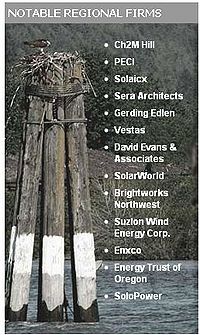
Oregon and Portland is becoming a green energy hub, [1][2] with utility scale energy generation using Wind, Solar and Wave, investments in electric car charging infrastructure, batteries and inverter technology, and a green building hub providing leadership nationwide.
Advocates say renewable energy companies have invested $5.4 billion dollars in Oregon to date and the wind and solar industries have become a vital part of our economic fabric. Wind and solar projects by companies like Horizon Wind Energy, enXco and NextEra have brought hundreds of construction jobs to Oregon and millions of dollars of tax revenues to rural communities.
Skeptics of renewable energy investments say the government should not be in the business of making bets. They site examples like Solyndra, which went bust soon after the federal government pumped more than $500 million into the solar start-up.
Governor Kitzhaber's new 10-year energy plan draft will take renewables, efficiency and green transportation from the marginal to the mainstream, all in the name of lower greenhouse gases, energy security and jobs, reports the Oregonian in March, 2012.
The Portland Development Commission is focusing on three core clusters within the cleantech industry, reports Sustainable Business Oregon.
- Clean energy, with a focus on wind- and solar-powered generation.
- Green development, which includes both green building technologies and energy-efficiency retrofits.
- Electric vehicles and the associated sectors, which includes energy storage.
For clean energy, the region's big players, are SolarWorld and Vestas. For green development, the PDC will continue to promote the building of the Oregon Sustainability Center, and for the electric vehicles, PDC will work with Drive Oregon and development-focused businesses such as Swiss battery technology company ReVolt.
Research firm Clean Edge surveyed more than 3,500 data points and 70 major indicators drawing from both municipal and private data sources to evaluate all 50 states in the U.S. for how well they did on policy, technology, and capital when it came to green tech. Oregon came in second, after California.
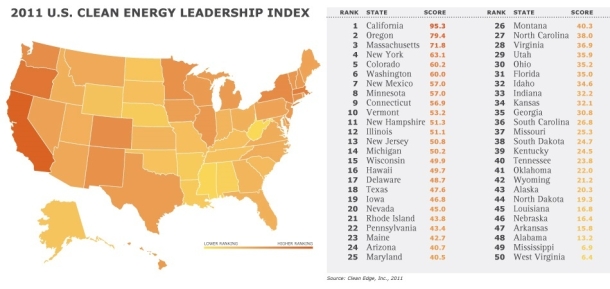

Ron Pernick, founder of Clean Edge, literally wrote the book -- The Clean Tech Revolution a 2007 book that proclaimed that commercializing clean technologies is a profitable enterprise. He highlighted eight major clean technology sectors: solar power, wind power, biofuels, green buildings, personal transportation, the smart grid, mobile applications, and water filtration.
Pivotal Investments created a list of future clean-technology leaders with a mix of early-stage entrepreneurs, investors and senior executives leading the charge in the Northwest.
Green businesses, say proponents, benefit Oregonians by bringing jobs and money here. The jury may still be out on longer term results, but it's undeniable that a large number of solar, wind and wave businesses, as well as related "green industries" have recently moved into Oregon and Portland.

There is another motivation for green industry; the sustainability of our environment and life style.
Coal-fired power plants and fossil fuel are the biggest contributors to global warming. Global warming is caused by releasing what are called greenhouse gases into the atmosphere. The most common greenhouse gas is carbon dioxide.
350 parts per million is what many scientists, climate experts, and progressive national governments are now saying is the safe upper limit for CO2 in our atmosphere. The current level is 392 parts per million. 350 PPM is supposedly the number humanity needs to get back to as soon as possible to avoid runaway climate change.

Barack Obama's American Recovery and Reinvestment Act of 2009 included more than $70 billion in direct spending and tax credits for clean energy and associated programs. While only 3 million Americans can beat grid prices with $3.50 per Watt solar and no incentives, 41 million Americans can beat grid prices using the 30% federal tax credit.
Sustainable Utility Power in Oregon
Oregon's legislature passed a law in 2007 that requires utilities to get at least 25 percent of Oregon's power from renewable sources by 2025.[3] For 10 years beginning March 2002, through Oregon's Renewable Resource Programs[4], Portland General Electric (PGE) and Pacific Power customers pay a 3 percent charge on their monthly bills for conservation and renewable resource programs under Oregon's electric industry restructuring law. About 17 percent of the funds, estimated at $10 million to $13 million per year, are for projects that generate electricity from renewable resources. The Energy Trust of Oregon[5] administers the funds. Its goal for renewable resources is that they supply 10 percent of the state's electricity needs by 2012, an eight-fold increase.That goal has been largely attained.
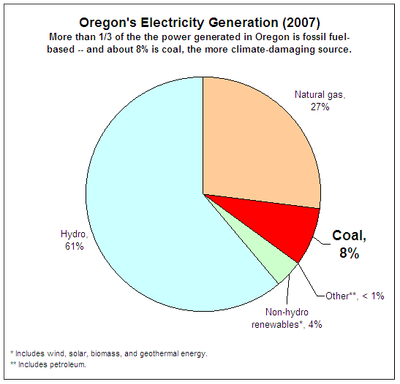
The U.S. is on a trajectory to generate 20% of the nation’s electricity from wind energy by 2030.[6] Wind and solar can (potentially) be cheaper than hydro, nukes or coal,[7] but renewables have more variables (like sun and wind) and can't store power (like a dam), or deliver on-demand power (like fossil fuel, hydro or nuclear). The U.S. spends about $1 billion a day importing oil, which is now over $100 a barrel[8], according to Energy Secretary Steven Chu[9]. The Advanced Research Projects Agency-Energy (ARPA-E) announced a $130 million to fund breakthrough energy technologies in five categories.
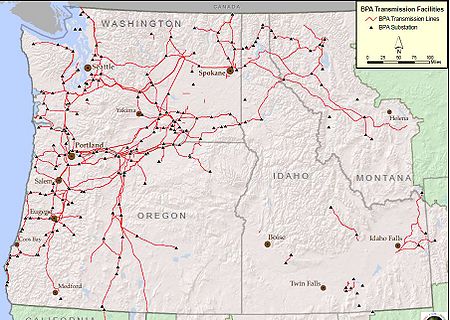
The Northwest is an energy exporter. The Bonneville Power Administration was created in 1937 to market electric power from the region's dams. BPA owns and operates approximately 75 percent of the high voltage transmission lines in the Pacific Northwest. Bonneville's headquarters are in Portland. It's one of four regional Federal power marketing agencies within the U.S. Department of Energy (DOE).
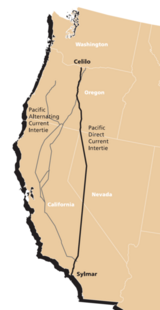
Power companies are provided with incentives by the federal government to get off coal and gas, often used to generate electricity. More sustainable alternatives, such as solar or wind are viewed as beneficial to the country's long term economic health. Dams are excellent power generators, but the Columbia River is nearly tapped out. Fishing issues and river transportation are also problematic.
The Dalles Dam[10], constructed by the federal government in 1957, is one of the largest "renewable" energy sources. It produces close to 1,800 megawatts of hydro power. Bonneville Dam, 40 miles east of Portland, has a capacity of 1.2 Gigawatts. The Grand Coulee Dam[11] is the largest electric power-producing facility in the United States and fifth largest producer of hydroelectricity in the world (2008), producing 6.8 Megawatts.
The Pacific DC Intertie[12], on Bonneville's grid[13], connects to Los Angeles with a line capacity of 3,100 megawatts.
The Northwest Power Act of 1980 called on the Northwest to give energy conservation top priority, since a megawatt saved is the equivalent of a megawatt earned (elsewhere). The Bonneville Power Administration is now launching their Post-2011 Energy Efficiency program.
Reducing dependency on foreign oil is a major thrust. Attracting innovative new businesses with growth potential and good jobs is another motivator.
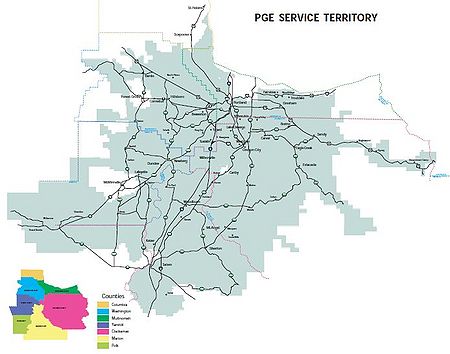
PGE serves over 800,000 customers within their 4,000-square mile service territory PDF, including 52 Oregon cities. They offer a variety of renewable energy options including a Clean Wind renewable power program.

Pacific Power provides power to 1.7 million customers in six Western states, with 555,000 customers in Oregon. Their parent, PacifiCorp, is a wholly owned subsidiary of MidAmerican Energy Holdings Company. Columbia Steel, near St Johns, is one of Pacific Power's biggest customers and purchases a portion of their electricity under their “Blue Sky” program. According to Columbia Steel, the 75,000 kilowatt hours per month obtained this way is the equivalent carbon offset of 1,137,666 car-miles not driven -- roughly equal to 12.5 miles per day for 350 employees.
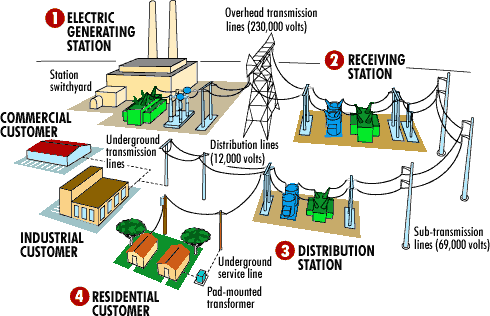
A giant ring of bulk substations surrounds Portland and Vancouver so that power delivery is redundantly supplied – power can circle to the customer in either direction. This ring consists of 10 Bulk Power Substations that create 115 KV Transmission Feeds to about 90 Distribution Substations.
The Federal Department of Energy, the State of Oregon and Portland aim to provide leadership in "green energy" and become a hub for sustainable innovations. Oregon is an energy exporter, tied into the grid through Bonneville. We also have lots of wind in the Gorge, Pacific Ocean waves, semi-conductor expertise for solar, and lots of scrap wood for cellulosic ethanol fuel.
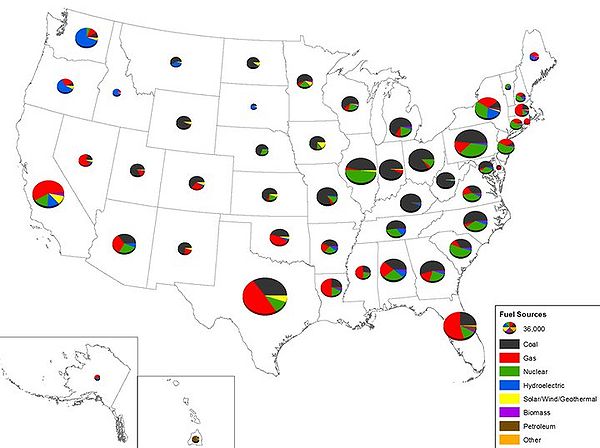
Unlike most states, Oregon generates abundant electricity from sustainable resources. It also exports a lot of electricity to California and other states. That makes transitioning to electric cars a good fit for Oregon and brings energy dollars home, rather than going overseas.

The U.S. electric grid is a complex network of independently owned and operated power plants and transmission lines, explains NPR. Aging infrastructure, combined with a rise in domestic electricity consumption, has forced experts to critically examine the status and health of the nation's electrical systems.
Projected Growth of Green Economy
The main renewable energy industries grew 35% last year[14], and revenues should double again this decade, according to the Clean Energy Trends[15], a research and advisory firm based in Portland. Clean Edge, founded in 2000 and based in Portland, is the world’s first research and advisory firm devoted to the clean-tech sector.

One kilowatt-hour of electricity runs a 1000 watt microwave oven for an hour. It sells for an average of 10 cents nationally.
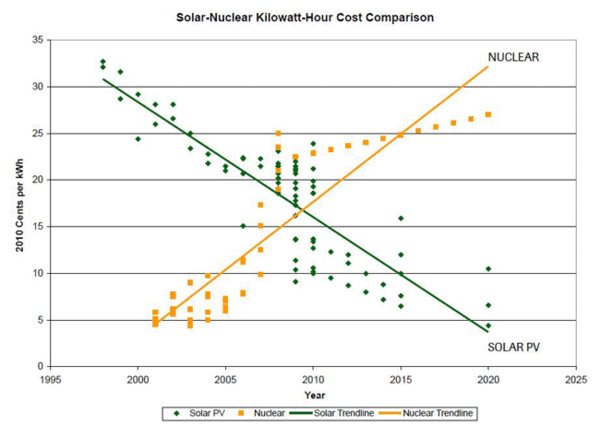
Grid parity[16] is when renewable energy costs are equivalent to non-renewables such as coal or oil. Grid Parity has been reached in Hawaii, where electricity costs around $.30 per Kilowatt hour (it's less then 10 cents in Oregon). Most of the US is expected to reach grid parity by 2015, says Wikipedia. Gas will go up as renewables come down. Achieving 10 cents per kilowatt hour cost for wind and solar power is achievable in the next few years say experts - but only if there's lots of wind or sun to harness.
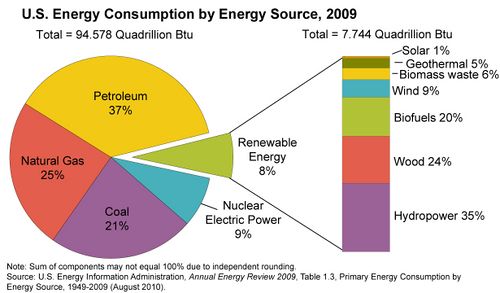
The Oregon Global Warming Commission was created by the 2007 Legislature. Keep Oregon Cool, is their website. A low-carbon economy[17] is generally regarded as essential for maintaining life as we know it. The goal: Zero carbon emissions globally by 2050 [18]. It's a huge challenge.
Wind Farms in Oregon
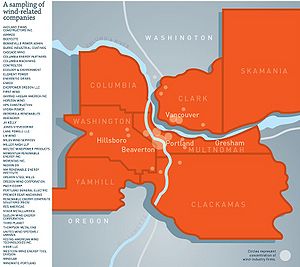
Wind power is one of the fastest growing forms of new electricity generation in the U.S., according to the American Wind Energy Association. In recent years, around 40% of all new generation capacity added to the electric grid in the U.S. was from wind power projects. A May 2008 Department of Energy study says wind power can provide 20% of the nation's electricity by 2030.
The Vestas[19] V90 is a 3.0 MW wind turbine, so over 200 would be required to produce similar power as the 550 megawatts produced at the coal-fired power plant in Boardman. But only when the wind is blowing. Wind farms like that can cost well over $1 billion - but the wind is free and it's non-polluting.
About 4 percent of PGE's energy comes from wind farms[20] — mostly the Biglow Canyon Wind Farm[21], plus power PGE purchases on contract from the Klondike II[22] and Vansycle Ridge[23] wind farms. The Stateline Wind Farm[24] runs along the Columbia River[25].
Wind Farms:
- Portland General Electric’s Biglow Canyon Wind Farm[26] is the second-largest wind energy facility in the state. Biglow's 141 Vestas wind turbines[27] produce 275 megawatts of power. The wind farm is located in Wasco County[28], near The Dallas, an area likely to get further wind development, despite growing community concern about noise and environmental impacts. The $1 billion project was completed in September, 2010[29]. Vestas[30], the largest wind turbine manufacturer, has its North American headquarters in Portland. Here's a video tour[31] of a Vestas tower at Biglow[32] and Sam Churchill's Flickr photo collection[33] of Bigelow (below).
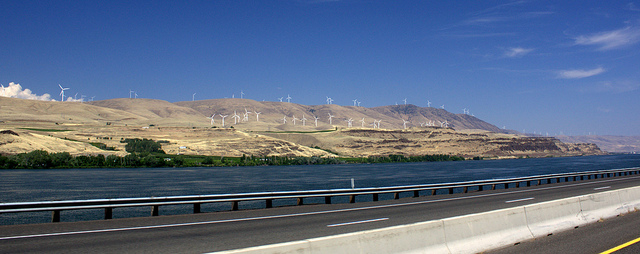
- Shepherds Flat Wind Farm[34], expected to be the world's largest, received a $1.3 billion loan from the DOE and will employ 400 workers during construction and 35 workers during operation. The 845 megawatt wind farm near Arlington, Oregon, will begin installation of the wind turbines in 2011 and is expected to be fully built in 2012. Built by Caithness Energy[35], it will supply electricity to Southern California Edison[36]. The wind farm, expected to be the largest land-based wind farm in the world when it is completed, will use 338 General Electric wind turbine, each generating up to 2.5-MW, their largest contract ever.
- Google will invest about $100 million in Shepherd's Flat, its second direct investment after it invested $186 million in the Ivanpah solar project under construction in California. That's a 392 megawatt geo-thermal power plant which uses mirrors pointed at a boiler in the middle. The power generated by the Shepard's Flat wind farm in Oregon will be sold directly to Southern California Edison through 20-year fixed price power purchase agreements. Construction of the Shepherds Flat Wind Farm is expected to create 400 jobs, with 35 permanent jobs supported on site once its created.
- Eastern Oregon wind farms, especially the Summit Ridge wind farm in Wasco County, have now been thrown into doubt[37]. In September, 2010, the U.S. Fish and Wildlife Service recommended that the Oregon Department of Energy allow wind turbines no closer than 6 miles to a golden eagle nest. That has also prompted Portland General Electric to back off its push to buy development rights for a massive new wind farm near Arlington in Gilliam County.
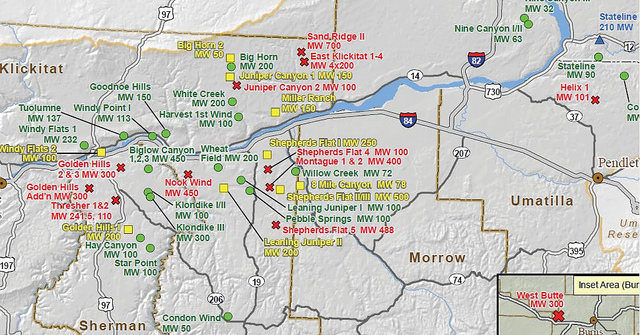
Iberdrola Renewables[38], headquartered in Portland, Oregon, is the second largest provider[39] of wind in the country has 41 wind farms in the United States with an installed capacity of 3,877 megwatts[40], enough to power close to 1 million average U.S. households. Klondike Wind Power[41], a subsidiary of Iberdrola Renewables, sells power to the Bonneville Power Administration[42]. Iberdrola's National Control Center in Portland receives data from approximately 800,000 sensors that monitor, weather, power generation and security at Iberdrola facilities around the country.
A SCADA system, supplied by PcVue relays wind speed, wind direction, shaft rotation speed and other data on every wind turbine.
Sales of small wind turbines[43] (100 kilowatts and less) in the U.S. grew from 2,100 units in 2001 to 9,800 units in 2009 (peak has been 10,386 in 2008), according to the American Wind Energy Association[44]. Electrical power is relatively cheap in Oregon (7 cents a kilowatt hour, compared to 29 cents in Hawaii) so often Oregonians who buy small wind turbines, especially for homes, aren't trying to save money but rather to invest in renewable energy and/or attain some energy independence.
Xzeres[45], a small-wind turbine manufacturer, is in Wilsonville. Oregon Wind's small vertical Helyx[46] is designed and manufactured in Portland, using locally sourced recycled materials.

As of November 2010[47], the two largest wind farms are in Texas; the 781.5 MW Roscoe Wind Farm[48] is the largest in the world, followed by the Horse Hollow Wind Energy Center[49] at 735.5 MW. The largest wind farm under construction is the 800 MW Alta Wind Energy Center[50] in California. The largest proposed project is the 10,000 MW Gansu Wind Farm[51] in China.
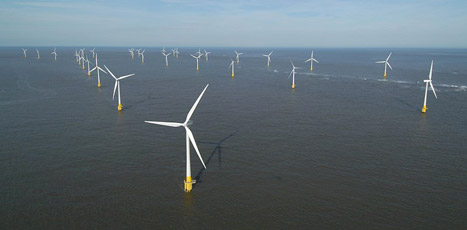
Principle Power designed the WindFloat platform, an offshore wind farm platform with Vestas supplying a 2-MW turbine to the pioneer project. Vestas has installed more than 1,000 MW of capacity in offshore projects in Europe. Vestas has announced it will complete the largest offshore wind turbine in the world. The V164-7.0 MW will be a colossal offshore turbine for the roughest North Sea conditions — notorious for its violent winds.
In 2005,GE was building 10 turbines a week and by 2008 it was building 13 a day. China's largest wind turbine maker,Sinovel, has replaced General Electric as the world's second largest such company, after number one Vestas.
The capacity of wind farms connected to the BPA's transmission network has ballooned from 250 megawatts in 2005 to more than 3,500 today, and is expected to double again in the next two years, reports the Oregonian's Ted Sickinger. That outstrips demand growth in the region. More than half the wind power generated in the Northwest is sold under long-term contact to California utilities, which are required to meet a third of their customers' electricity needs with renewables by 2020.
BPA completed a new 79-mile 500-kilovolt transmission line through Clark and Cowlitz counties in February, 2012. It links the McNary Substation to the John Day Substation along the Columbia River. It's one of several planned in Washington and Oregon to get power from wind turbines east of the Cascades to urban centers on the west side.
But questions are mounting about wind energy development with a new California law that requires more of that wind energy to be generated locally, instead of being imported from the Northwest.
The BPA will pull the plug on wind farms when excess generation threatens to swamp the system's ability to handle it. BPA's decision is almost certain to trigger litigation from wind farm operators, who won't then generate expected financial returns. At peak hydro generation times, in the spring and fall, dumping water through the dams' spillways raises dissolved nitrogen levels in the river, which can harm migrating fish. Wind companies say that will harm their business. A tentative compromise would have BPA pay for half the wind farm's losses during those events.
PGE[52], the state's largest utility, hopes to shut down the state's only coal-fired power plant 20 years earlier[53] than planned. PGE has natural gas and coal-fired power plants in Boardman and has proposed one or two additional natural gas plants there, if it closes its Boardman coal plant to meet haze-reduction rules or avoid carbon taxes[54]. The 585-megawatt coal fired plant[55] provides enough electricity to serve about 250,000 residential customers.
Solar Power in Oregon & Portland
The U.S. solar power industry grew 67 percent to $6 billion in 2010[56], up from $3.8 billion in 2009, according to the Solar Energy Industries Association[57]. Their report indicates the U.S. Solar Market installed 878 megawatts (MW) of photovoltaics in 2010, more than double the 435 MW installed in 2009.
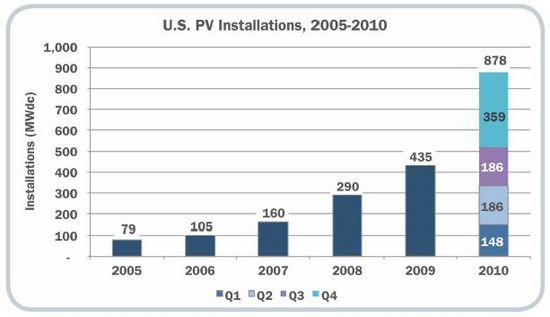
Prices for solar panels have declined by around 75% in the past 10 years and now contribute less than half the total installation cost of an average rooftop system. Solar panel prices in the U.S. are set to drop by $0.20 per watt in 2011, bringing the average panel price down to $1.40 per watt. By 2015 the cost of PV systems is expected to drop by an additional 40% compared to current levels. PV systems then are expected to compete with electricity prices from the grid in many locations around the United States.
Oregon's KW/hr rates are generally the lowest in the country. Our cloudy weather combined with our low electricity rates make solar less attractive as a renewable energy source. The solar industry, however, finds Oregon an attractive location for manufacturing, due to our silicon expertise and infrastructure.
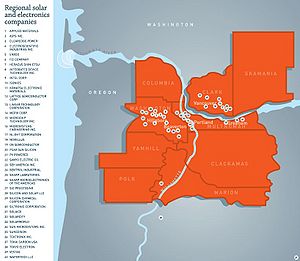
Crystalline silicon panels[58], like those made by industry leader SolarWorld in Hillsboro, Oregon[59], dominate 90% of the industry today[60]. Silicon prices have dropped recently, making traditional Monocrystalline silicon[61] more competitive, on a cost per watt basis, although competition from China is a constant worry.
The Portland region is positioning itself to be a production center for all three major photovoltaic technologies; Crystalline silicon[62], Cadmium Telluride[63] and Copper Indium Gallium Selenide[64].
- Monocrystalline is the most efficient, which makes it well matched for the limited area available on homes and businesses.
- Cadmium Telluride costs less, but is less efficient, so it's often used on utility scale projects with lots of real estate.
- Copper Indium Gallium Selenide is flexible, with medium efficiency and is often used in panels integrated with buildings or roofs.
Thin-film technology has proved challenging to commercialize[65], although both major thin film technologies; Cadmium telluride[66] and CIGS[67] seem posed to provide a more streamlined production process, lowering costs.
Cadmium telluride panel[68] manufacturers, like Solexant[69], in Greham, Oregon, claims they can manufacture solar panels for less than $1 per watt, while Startup CIGs developer SoloPower[70] is using a roll-to-roll electrodeposition process, as opposed to the sputtering, printing or evaporation used by most CIGS vendors. SoloPower says this allows it to utilize nearly 100 percent of the chemicals it employs in the process, which is much greater than the rate achieved using other CIGS processes.
Whether thin films will represent a huge shift in energy economics[71] remains to be seen.
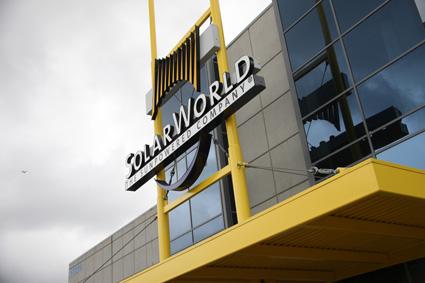
Photovoltaic manufacturers in the Portland region include:
- SolarWorld[72], the largest manufacturer of solar panels in the United States. The company unveiled its 210,000-square-foot addition[73] to its Hillsboro, Ore., manufacturing plant in 2010. It is now the only monocrystalline solar manufacturing plant in the United States to produce every phase of solar panel manufacturing. SolarWorld will collaborate develop a 11.6-megawatt solar system[74] with the LA Department of Water and Power, using more than 46,000 solar modules on the 42-acre site. SolarWorld has been supported partly by tax incentives from the city of Hillsboro, the state of Oregon and the US government via the Recovery Act. SolarWorld Group has its main manufacturing operations in Hillsboro and in Freiburg, Germany.
- SANYO Solar[75], claims to manufacturer the world’s most efficient solar panels, and has opened a monocrystalline growing facility in Salem, Ore[76]. The plant, spanning 130,000-square-feet at the Salem Renewable Energy and Technology Center and employing 200 highly skilled workers, represents an investment by SANYO of more than $84 million. Sanyo Solar grows crystals in Salem and slices them into wafers, which Japanese workers make into cells that go into panels in Japan, Hungary or Mexico.
- Cadmium Telluride developer Solexant[77], plans to build a $200 million solar manufacturing plant in Gresham[78]. The company plans to construct a 100,000-square-foot manufacturing plant that will initially employ 100 before growing to 170 at full production. Long term, the company hopes to eventually expand the facility to manufacture panels capable of generating 1,000 megawatts. Solexant's facility in Oregon[79], producing 100-megawatts of thin film CdTe[80] solar panels annually, will be the largest nanotechnology manufacturing facility in the world[81]. Long-term, the company hopes to expand the facility to 1000MW annually, reports Oregon Live[82]. Such a facility could employ as many as 1,000 workers.
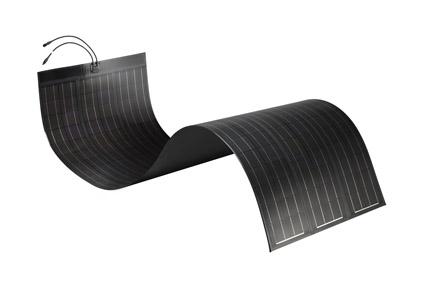
- CIGs developer SoloPower[83] planned building a manufacturing plant in Wilsonville[84]. But in a surprise move, SoloPower officials announced plans in May to bring a $340 million solar plant to North Portland, abandoning an $11 million incentive package tied to Wilsonville. SoloPower says it will initially employ 170 people, possibly increasing to 500 employees within five years.The $56 million manufacturing plant could employ 500 people within five years[85], says the company. SoloPower received a $197 million loan from the DOE, in February, 2011, to support construction of their Wilsonville plant. SoloPower's tough but flexible solar panels[86] are said to enable inexpensive roof mounting. Their expansion plans call for three more manufacturing lines[87], growing the plant’s capacity to 300 megawatts and its employment to around 500. SoloPower also sought and received a $20 million loan from the Oregon Energy Loan Program.
- Grape Solar[88] doesn't grow silicon crystals or make solar cells at its Eugene headquarters. Essentially, it just imports low-cost solar panels from China and re-sells them here[89].

SolarWorld, facing fight for survival, is seeking tariffs on Chinese solar products flooding the U.S., reports The Oregonian. The dispute has deeply divided much of the solar industry. The Coalition for American Solar Manufacturing(CASM) supports SolarWorld.

But the newly formed Coalition for Affordable Solar Energy which represents 132 companies, many of which rely on panels coming in from China, are against it. They say the trade complaint is “short-sighted” and would lead to higher-priced solar panels that could disrupt the growth of the U.S. market.
Frank Asbec, Solarworld CEO, said that some European solar energy companies may also sue Chinese photovoltaic companies and India is considering its own investigation into Chinese solar imports. Members of a U.S. trade commission voted unanimously to support SolarWorld in its case against China, concluding that Chinese trade practices have harmed American solar manufacturing.
Solyndra has been the poster child for those who oppose government subsidies of green energy. On September 1, 2011, the company ceased all business activity, filed for Chapter 11 bankruptcy, and laid off all employees, barely a year after receiving more than $500 million in federal loan guarantees.

Solyndra planned to build cylindrical panels of CIGS thin-film solar cells in a new $733 million state-of-the-art robotic facility which opened in September 2010 in Fremont, California. It was built with the support of a $535 million federal loan guarantee along with at least $198 million from private investors.
Both Solyndra and First Solar are based upon non-silicon thin-film. But Solyndra's higher production and distribution costs, along with a declining cost of higher efficiency Silicon killed its viability.
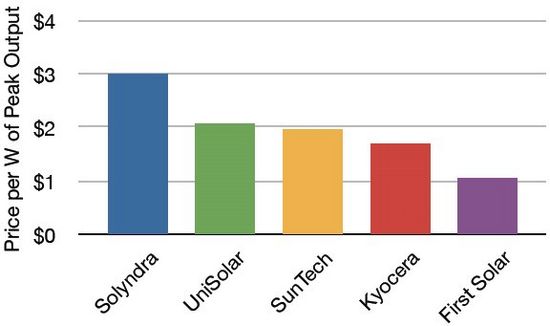
Critics claimed that the Obama administration had unduly influenced awarding the loan guarantee. In December 2011, The Washington Post published an in-depth examination of the scandal and the other elements of the Obama green technology program. Meant to create jobs and cut reliance on foreign oil, Obama’s green-technology program was infused with politics at every level, The Washington Post found.
The Solyndra loan controversy is a cloud that still hangs over green energy subsidies.
Lux Research, in a new report, projects the CIGS market will nearly double to $2.35 billion and 2.3-gigawatt demand in 2015, up from 1.2GW today, as the technology emerges "into an early growth phase."
North Portland-based Global Solar has shown "slow but steady progress" with its CIGS-based PowerFlex technology used in Dow's solar shingles, but "needs to adopt a less conservative approach," according to the Lux research report.
Large Solar Arrays installed in Portland
The largest solar project in downtown Portland is a $366,000, TriMet installation near Portland State using 253 Solar World SW-240 panels to generate 61 kW. You can monitor their energy production live.
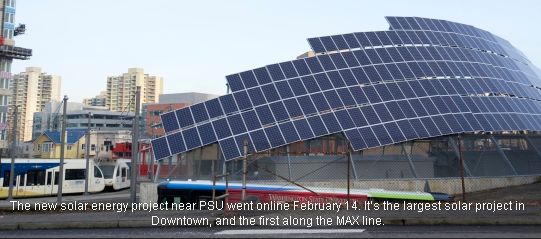
TriMet sought and received a grant from the American Recovery and Reinvestment Act to build the $1.2 million steel structure surrounding the utility buildings at the MAX turnaround. Incentives and tax credits reduced the $366,000 cost of installing the panels by more than 70 percent, according to TriMet.
According to TriMet's Fact Sheet, the next largest system is at PSU's Lincoln Hall. It provides 54 kilowatts of electricity, or about 2 percent of the building’s energy needs.
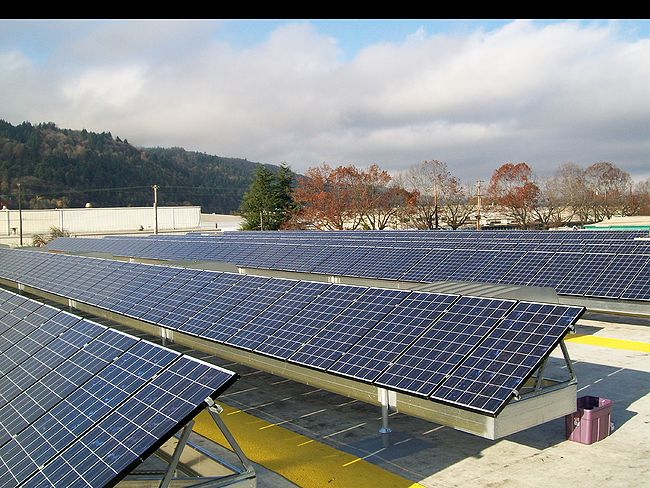
Outside the central business district, Powell's Books Warehouse in the Northwest industrial area has a 100 kW system using 540 solar panels while Portland Public Schools has several 100+ kW systems throughout eastside and Northeast Portland.
Ikea powered up a nearly 500-kilowatt rooftop solar system atop its Portland store near the airport in the spring of 2012, reports Sustainable Business Portland. It is made up of 2,072 panels. REC Solar designed and installed the system, which Ikea owns and operates.
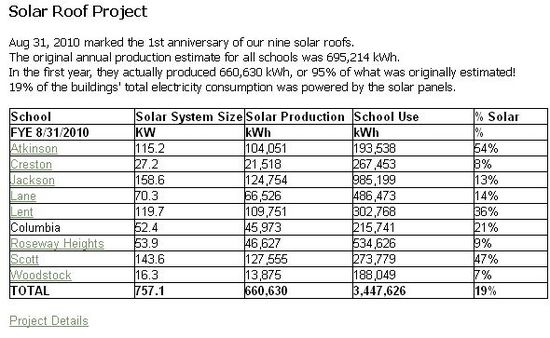
Solar4rschools.org has a map of solar projects around Portland.
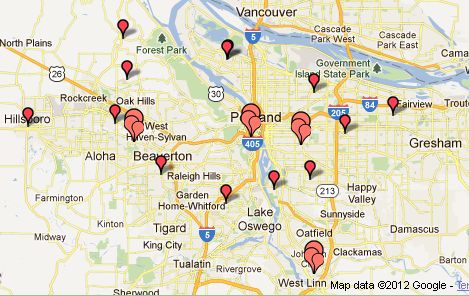
Intel has three, 400 kilowatt solar arrays in Hillsboro. Already the nation's largest buyer of green power, Intel plans to buy 2.5 billion kilowatt hours of renewable energy credits this year, a 75 percent increase over 2010.
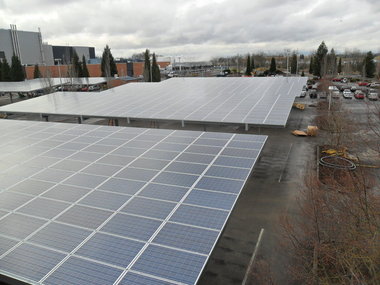
Intel last year completed eight solar energy projects at its plants in four states. Among them were two 400-kilowatt systems atop raised support structures within the parking lots of its Jones Farm and Ronler Acres campuses in Hillsboro. According to data collected by the EPA, Intel used 2.5 billion kilowatt hours of solar and wind power last year, a combination of on-site generation and purchases of green power through a third party. In all, 88 percent of Intel's energy needs were met by green power.
The largest solar installation in the state will be a 2-megawatt solar array that PacifiCorp will develop in Lake County, Oregon. A motorized tracking system on the 9,000 photovoltaic panels will follow the sun, producing enough electricity to meet the annual needs of about 400 average residential customers. It will count toward the utilities obligations to produce 25 percent of its power from renewable sources by 2025 under the state's renewable portfolio standard.
Advanced Energy Systems[90] is the leading commercial solar integrator in Oregon, with commercial solar energy systems for Lewis and Clark College, ODOT, Kettle Foods, Pepsi-Cola, and other Oregon businesses.
Urban solar systems - with lots of grid power available - often skip expensive and troublesome battery storage. Power companies, provided with incentives to get off dirty coal, are willing to buy wind and solar generated power.

The nation’s first Solar Highway project[91] (right) started feeding electricity into Portland's electricity grid on Dec. 19, 2008. PGE’s “Oregon Solar Highway”[92] is a 100kW system that contains about 8,000 square feet of solar panels extending about the length of two football fields.
The "Solar Highway" installation incorporates a SolarWorld PV array and the Solar Energy Grid Integration Systems[93] (SEGIS), a DOE program to develop photovoltaic (PV) systems that seamlessly integrate into the distribution and transmission grid. The site doesn't store electricity - it just sells "green power" back to PGE. The total budget of that project was about $1.3 million, with ODOT buying the electricity at the same rate it would otherwise pay PGE for power, now about $0.06 per kilowatt-hour (pdf).
The "largest solar highway project in the nation" is now expected to be built along northbound Interstate 5 just south of Wilsonville. According to ODOT, it will produce approximately 1.9 million kilowatt-hours of renewable energy each year using thin film panels. That's more than ten times the power of the 594 Solar World panels that generate some 130,000 kilowatt-hours annually at the first Solar Highway project.
The 1.75 megawatt solar array South of Wilsonville is claimed to be the largest (solar highway) installation in the world, but ODOT will continue to add more solar to its energy supply through its solar highway program, including adding 150 kilowatts to the demonstration project site, a 3 megawatt project on I-205 at an ODOT Maintenance storage, and developing a project with PacifiCorp near Medford.
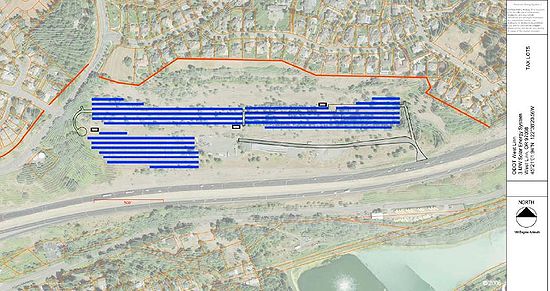
The proposed 3-megawatt (MW) West Linn Solar Highway project (above) would consist of the installation of approximately 13,000 230-watt PV modules and ten 260-kilowatt (kW) inverters pdf.
SunWize Systems installed a roof-mounted solar project at the Benton County Fairgrounds in Corvallis, the second largest solar installation in Benton County. An American Recovery and Reinvestment Act grant of $491,000 from the DOE helped fund the 70 kW solar electric system. The panels are installed on the roof of a 25’ x 30’ educational facility, with the system’s electrical equipment visible behind glass windows.
Outback Solar, located on 640 acres in Lake County on a former military radar based in Christmas Valley (below), will be the largest solar facility in the state of Oregon.
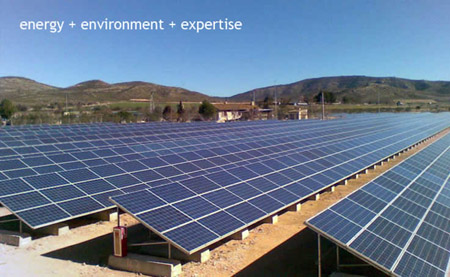
Element Power, a Portland-based company, obtained a conditional use permit from Lake County to build their 12-megawatt (MW) facility on approximately 100 acres of private land. It should be completed by the middle of 2011 and will tap into existing infrastructure, including high voltage transmission lines and access roads.
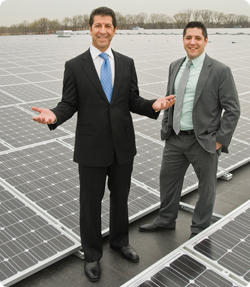
The largest rooftop solar energy system in the nation was designed and installed by Portland-based Solar Nation (left) using solar panels made by SolarWorld in Hillsboro.
The 4.26-megawatt system will produce more than 5 million kilowatt hours annually, using 17,745 solar panels. The installation will create an estimated energy savings of $200,000 per year, with a payback period of seven years. Solar Nation is now expected to move much of their operation to New Jersey where electricity runs $.30 a kW hour.
Teanaway Solar Reserve[94] announced plans for a 75-megawatt plant made up of 400,000 photovoltaic panels[95], 4 miles North of Cle Elum, Washington[96], near Ellensburg, although not much has been heard about those plans recently.
The University of Oregon's SuNRISE lab contains $1 million of state-of-the-art equipment to analyze solar cells[97].
Microinverters[98] can be installed on each panel to eliminate the "Christmas light" effect, where shadow on one panel can kill a serial-connected string. With microinverters, each panel outputs 110 volts AC. If one panel is in shadow it does not effect the output of other panels. Enphase[99] has pioneered this technique and offers online monitoring of your installation[100] - here's a 4.81 kW solar array in Portland[101].
PV Powered[102], based in Bend, goes the opposite route, offering utility-scale inverters such as their 260kW, 97% efficient[103] commercial inverter.
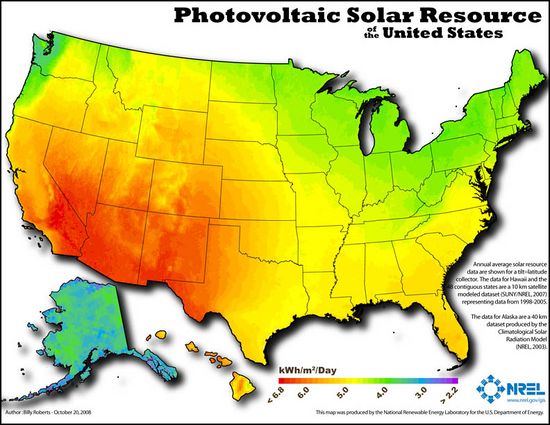
The National Renewable Energy Laboratory[104] has solar maps of the United States. Oregon may be a good place to make solar panels, but our sunshine pales compared to America's Southwest.
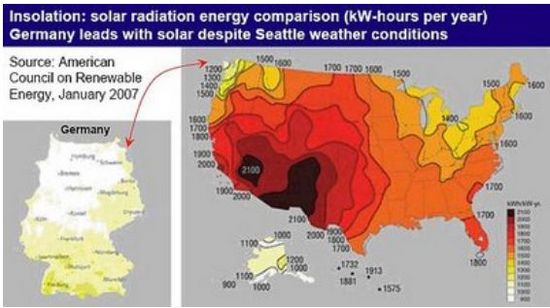
Proponents of solar energy say Germany gets similar solar exposure as the state of Alaska. Yet Germany is the global leader in solar installations. In Germany, the industry boomed after the Renewable Energy Act in 2000[105], which guarantees investors above-market fees for solar power for 20 years from the point of installation. Germany added 7 gigawatts (GW) of capacity in a record-breaking year in 2010 to bring the total to nearly 17 GW, equal to 17 large power plants.
According to three industry experts[106], though 13 percent of power generated in Oregon comes from wind and solar, solar makes up less than one percent of the mix, or less than one tenth of one percent of the state's total energy picture.
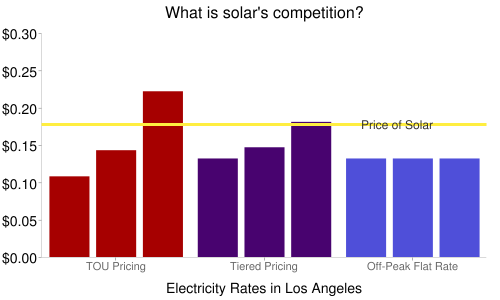
A very rough calculation of a solar array in Los Angeles finds that the average value of a solar-produced kWh is 15.1 cents over a year. That suggests that solar power is not yet at grid parity, even with time-of-use pricing. Solar is cheaper than nuclear energy[107], according to Duke University[108]. iSuppli predicts that around 13.6 GW of PV will be installed this year[109].
The DOE's SunShot Initiative aims to reduce the total costs of photovoltaic solar energy systems by about 75 percent by the end of the decade, so that they are cost-competitive with other forms of energy without subsidies. Right now solar costs as low as $1/watt to manufacture, but $4 installed. A coal plant has an operational cost of $2.10 per watt. It's estimated the solar industry will get to $2 per watt within the next five years[110]. But the sun don't shine at night.
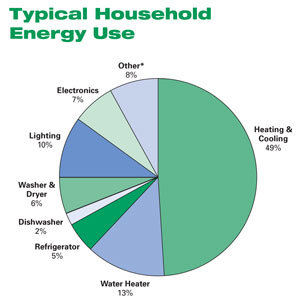
The Obama administration plans to fast-track utility-scale solar projects on BLM “solar energy zones” in six western states. But Oregon didn’t make the list[111], so any projects proposed on Bureau of Land Management land here – in southeast Oregon, for example – will have to go through a longer permitting process.
The 290-MW Agua Caliente Solar Project, 65 miles east of Yuma, Arizona, will contain five million panels when it is completed in 2014. That's a lot of First Solar panels.
Currently, the largest solar power installation in the world[112] include the 48-MW Copper Mountain Solar Facility in Nevada[113], finished on Dec 1st, 2010, now the largest PV plant in the United States. More than 350 construction workers installed 775,000 First Solar panels that power the plant on the 380-acre site. Power from the Copper Mountain Solar Facility[114] (and the adjacent 10 MW El Dorado Solar Power Plant) has been sold to Pacific Gas & Electric under separate 20-year contracts. The completion of the project eclipsed the 20-MW DeSoto PV plant in Arcadia Florida, which was the previous record holder for the largest U.S. solar power plant.
NRG Energy[115] recently bought the 290-megawatt (MW) Agua Caliente solar project[116] in Arizona. The project, scheduled to be completed by 2014, is expected to be the largest operational photovoltaic (PV) site in the world. Agua Caliente will use First Solar thin-film panels. Solar thermal uses mirrors to boil water. It's being used to generate electricity in California, Nevada and elsewhere.
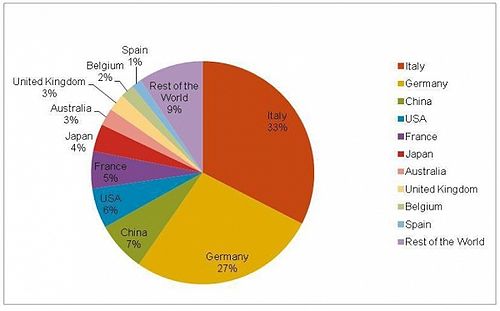
The two biggest photovoltaic markets in 2011 were Italy and Germany, which account for nearly 60% of global market growth of photovoltaics during the past year, according to the European Photovoltaic Industry Association.
The Obama administration has approved a thousand-megawatt, $6 billion solar project in California[117] on federal land, spread over 7,000 acres. Solar panels, to be competitive without government subsidies, will have to cost $1 per watt says the DOE[118].
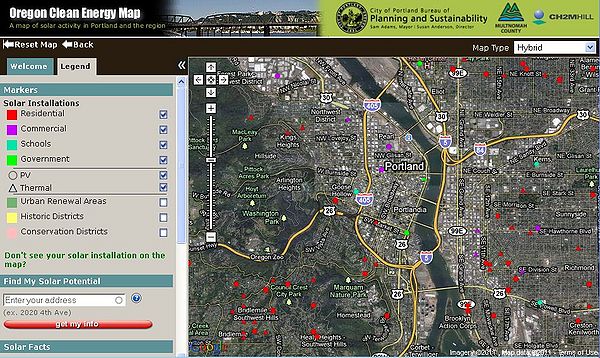
Portland's Bureau of Planning and Sustainability has created the Oregon Clean Energy Map showing solar information. The Bureau of Planning and Sustainability founded Clean Energy Works Portland, a Solar Energy Program, a Biofuels program and offers marketing and technical expertise to Solarize Portland, a solar panel volume-purchasing program.
Solar, like wind and hydro, is a long term investment with a significant front-end cost. A variety of financing instruments can make it profitable over 7-10 years. The idea is to phase out government subsidies in 5 years or so and become more self-sufficient. Solar enables individuals and businesses to take charge of their own destiny, bringing grid power home while lowering cost and green house gases.
With cheap hydro power and lots of wind available in the Northwest, sun power would have to get lots cheaper before it becomes a significant player here. But they said the same thing in Germany, with a similar climate, ten years ago. It's now a world leader in solar power generation.
Wave Power
Wave Power[119] captures the horizontal and vertical movements of tides and waves to generate energy. Wave energy[120] can harness both ocean waves and strong sub-surface currents to generate electricity. One advantage of wave power is that, unlike sunshine or wind, it may have the potential to generate power, 24/7. The United States has committed $200 million in federal funds toward wave energy technology[121] , from 2008 through 2012.
The nation's first commercial wave-energy farm[122], designed by Ocean Power Technologies[123], is now underway off the Oregon coast. Once fully deployed, the $60 million system is expected to have a capacity of 1.5 megawatts[124] — about half that of a single giant wind turbine - though waves should produce power around the clock. Surfpower[125] and Renewable Energy Research have expressed an interest in exploring their options in Oregon[126] , according to Oregon Wave Energy Trust[127] .

Ocean Power Technologies[128] is close to getting a license to build a wave energy plant off the coast of Oregon[129]. The New Jersey-based company has signed a settlement agreement that includes over 11 government agencies, and several private companies, to develop a 150 kW wave energy station[130] . When completed the plant will consist of 10 PowerBuoys that could generate enough electricity to power 1,000 homes annually, according to Ocean Power. A 10-Megawatt OPT power station[131] would occupy approximately 30 acres (0.125 square kilometers) of ocean space.
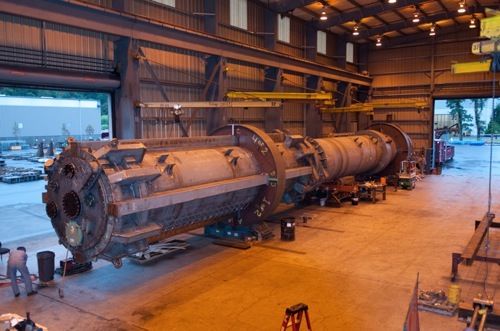
The first buoy will measure 150 feet tall by 40 feet wide, weigh 200 tons and cost $4 million. Nine more buoys are planned to deploy near Reedsport, Ore., by 2012, at a total cost of $60 million. Ocean Power Technologies has contracted with Oregon Iron Works[132] to build the buoys. Clusters of buoys would cover a five-mile stretch, north to south, less than three miles from shore.
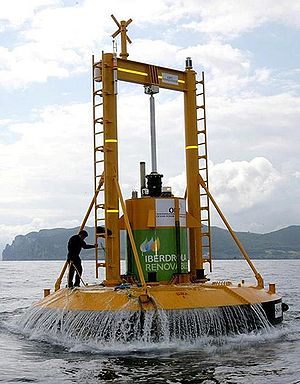
Columbia Power Technologies[133] has deployed an intermediate scale prototype near Seattle, controlled remotely from Corvallis. Columbia Power was founded in 2005 by Greenlight Energy Resources, in partnership with Oregon State University. Their design was the first ocean energy device to produce kilowatt scale electrical energy[134] off the Oregon coast. It will generate energy between one and three miles offshore[135].
Grays Harbor Ocean Energy[136] plans an offshore wave energy generation platform in shallow coastal waters 2.8 miles off of the Washington towns of Westport and Ocean Shores in Grays Harbor of Washington state.
Whether or not wave energy facilities should be sited inside the newly proposed marine reserves off the Oregon coast is currently a hotly debated topic[137] . The trick is to tap the benefits of a new industry without spoiling ocean habitats, economic livelihoods and recreational playgrounds[138] . Off shore energy policy[139] is still being worked out. No state agency in the U.S has ever permitted a wave energy project[140].
A wave-power device from another company, Finavera[141] , sank off the Oregon coast two years ago.
Other Oregon wave energy players include Aquamarine[142] , a Scottish company with a technology called The Oyster with an office in Newport, a Scandinavian company, Floating Power Plant, Norway’s Wave Energy A/S[143] in Tillamook looking at a jetty-based device, and a possible Texas-based[144] startup called Neptune Wave Power[145].
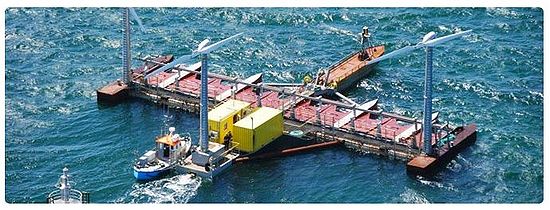
Floating Power, a Danish company, that spent the last 12 years developing and testing a power-generating platform called "Poseidon", plans to commercialize and manufacture the technology in Oregon. Under the joint venture agreement, Oregon-based Floating Power will hold the exclusive rights to commercialize Poseidon installations throughout the Americas and at U.S. government installations worldwide. It generates both hydraulic power from waves interacting with floats and electricity from wind using turbines mounted on the platform.
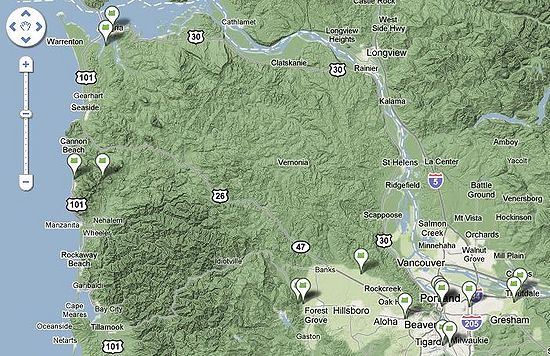
The Oregon Wave Energy Trust recently matched 20 percent of costs for four companies that won federal grants to develop wave energy projects or technology in Oregon. They include M3 Wave Energy Systems of Salem, Shift Power Solutions of Encinitas, Calif., developing a breakwater that can generate electricity from waves, Northwest Energy Innovations, of Portland, with wave energy partnership with New Zealand-based Industrial Research Limited. Principle Power of Seattle is researching a floating wind turbine that converts wave energy into power at a site near Tillamook.
The Northwest National Marine Renewable Energy Center[146] is a partnership between OSU and UW. OSU focuses on wave energy. UW focuses on tidal energy[147]. Both universities collaborate with each other and the National Renewable Energy Laboratory[148].
Pacific Energy Ventures[149] (Portland, Oregon) will build a Protocol Framework for identifying, collecting and comparing environmental data relevant to offshore renewable energy projects Oregon Wave Trust[150] is designed to serve as a connector for all stakeholders involved in wave energy project development. Oregon Wave Energy Trust[151] is a nonprofit public-private partnership funded by the Oregon Innovation Council.
Electric Cars in Oregon
President Obama wants to cut U.S. oil imports by a third over 10 years, as high gasoline prices threaten economic recovery. The U.S. has lurched from different transportation energy policies[152] in the past several years, favoring fuel cells and then biofuels and now electrification and hydrogen. How far electrification will go is still unclear. Electric vehicles will reduce green house gases and dependence on foreign oil say advocates.
Oregon is coordinating many activities to facilitate successful, widespread deployment of plug-in vehicles[153], reports the Department of Energy. In 2004, Oregon's strategy for greenhouse gas reduction report[154] showed that motor vehicles accounted for more than one-third of Oregon's GHG emissions.

Portland Mayor Sam Adams has pledged to implement a "comprehensive Green Fleet vehicle plan" that includes having 20% of the City's 2,800 vehicles run on electricity by 2030.

There are 40 companies building either electric vehicles or component parts[155], says Drive Oregon[156]. Oregon-made electric vehicles[157] include Arcimoto[158] Brammo[159], Ryno Motors[160], Green Lite Motors[161], MotoCzysz[162] as well as EV Charging Station manufacturers Shorepower[163] and Optimization Technologies[164]. Charging overnight, at non-peak times, helps balance demands on the grid and grid energy storage[165] may help demand spikes.
Ryno Motors was conceived by inventor Chris Hoffmann’s daughter. She envisioned a Starwar's like scooter with a single wheel. Hoffmann built it, and hopes his Vancouver, Washington, start-up will change urban transportation.
Since 2009, the DOE has invested more than $5 billion in grants and loans to spur the growth of the U.S.' electric-vehicle and advanced battery manufacturing industry. Under the Transportation Electrification Initiative (TEI), which received $400 million under ARRA, the federal government hopes to assist in deploying over 22,000 charging points in residential, commercial, and public locations nationwide by December 2013. President Obama has set an ambitious goal of putting 1 million electric vehicles on the road by 2015. Today, that number is essentially zero.
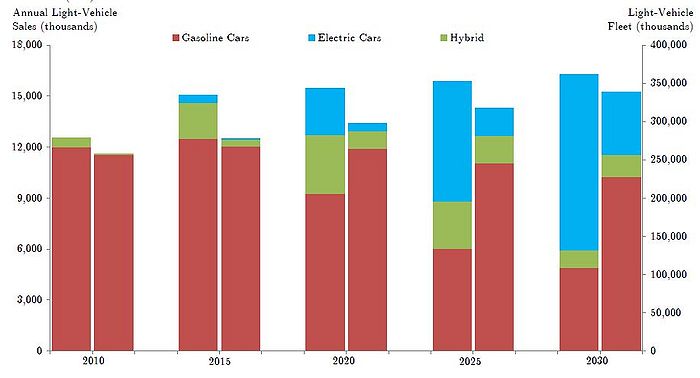
Sales of electric vehicles in the United States (above) is expected to grow dramatically in the next 10-20 years, even under conservative scenarios, says a Berkeley study.
But small, under-the-radar electric car companies, face big competition, say industry observers. Think, a Norway-based automaker that makes the two-seat electric car, for example, had battery maker Ener1, which held a 31-percent equity stake, bail on their relatively expensive vehicle.
CT&T United, the world's largest manufacturer of battery electric vehicles, announced plans to hire hundreds of Americans in new factories in Hawaii, Pennsylvania and South Carolina. But the South Korean electric car and golf cart manufacturer has apparently abandoned that pledge — without notice — amid financial difficulties.
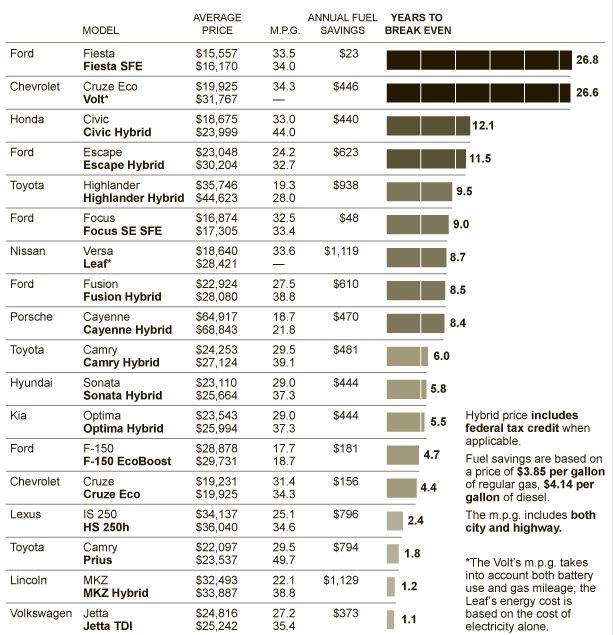
Practically speaking, payoff for efficient cars takes years, figures the NY Times. Currently, you have to save a lot of gas to make up the difference in cost. Cheaper batteries and more expensive gas changes the equation.
Tesla Motors plans to raise $234 million through a secondary IPO, while Fisker Automotive says that it will have 45 dealerships across the U.S. by the end of July.

The Nissan Leaf[166], an all electric car[167], is being tested in Portland, as are Chevrolet Volt[168] and Ford's Focus Electric[169]. Plug-in hybrids[170] have much smaller batteries, running perhaps 10-40 miles on electricity before using a gas engine.
Chevrolet's Volt[171] (right) is a variant of a plug-in hybrid, in that it goes about 40 miles on batteries and can be plugged in at night. It doesn't switch to gas drive train like the Prius. Instead, the Volt's gas motor drives an electric generator for the car. The best selling Toyota Prius[172] uses a conventional gas engine but runs on a small battery for the first 4-6 miles. The plug-in hybrid Prius[173] has a bigger battery with a 12 mile range. Batteries can be recharged by plugging them in. That's cheaper than using the car's gas-powered generator to charge them up. Zip Car in Oregon is now offering two plug-in Prius cars for $7/hr.
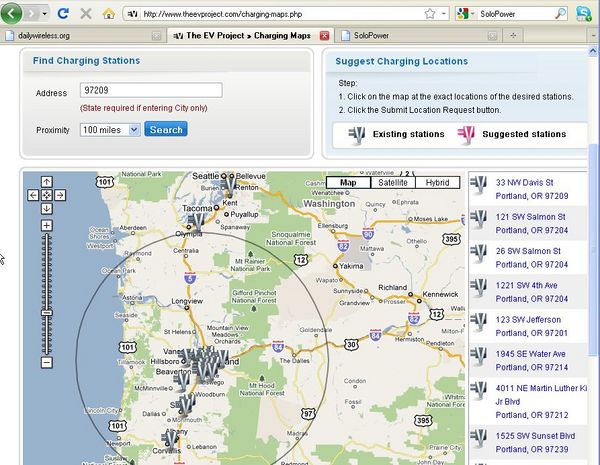
Ford named Portland as one of the 25 best cities for electric cars. Ford is gearing up to launch the all-new Focus Electric later this year and C-MAX Energi plug-in hybrid in 2012.
Both the ground breaking Nissan Leaf[174] and the eStar will be limited to a 100 mile range on their Lithium Ion batteries[175]. The Leaf runs only on batteries. When it's out of juice, it's dead. The Nissan Leaf costs $33,000 (before rebates), and has been described as a $16,500 subcompact car that costs double that thanks to a battery estimated to cost $16,500. The Navistar eStar[176], an electric truck, will sell for $150,000 and totes a battery estimated to cost nearly $75,000.
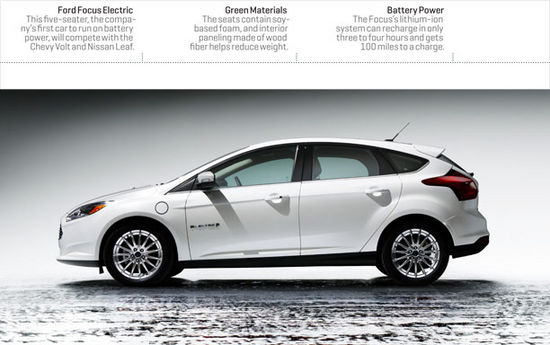
About 25% of Ford's fleet will be electrified by 2020, up from just a couple percent today, says CEO Bill Ford. But the price of oil is hard to predict, so Ford is investing in hybrids, plug-in hybrids, and pure electrics.
Charge Stations in Oregon

Oregon's Electric Vehicle Charging Network[177] is extending electric car charging stations along the I-5 corridor. It costs only $2-$3 to charge up an all electric car. Electric vehicles keep oil money in the country and may develop a new industry based on innovation - or so the thinking goes.
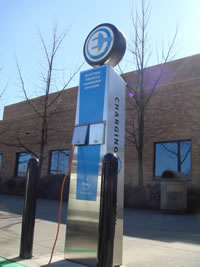
Chargeportland.com provides information about electric car charging stations and how to apply for an online permit for your electric vehicle. ECOtality's Fast chargers[178] are available in Portland and Eugene, south to the California border creating a system of electric vehicle (EV) charging stations along the entire length of Interstate 5 in Oregon. ECOtality will oversee the installation of nearly 15,000 Blink charging stations in 18 cities and major metropolitan areas in six states and DC.
Eaton Corporation and Mitsubishi will make charging stations at its 85-person plant in Wilsonville. So far, the market has been led by startups such as Coloumb Technologies and ECOtality, the San Francisco-based company leading the federally fund EV Project.
Other local companies such as Shorepower Technologies (left) and Beaverton-based OpConnect are also trying to carve out space in the market. BP plans to install up to 1,000 chargers at BP and Arco gas stations along the Interstate 5 corridor.
AeroVironment has been selected by ODoT to install its high-power Level 3 fast charging stations along the I-5 corridor. The stations will be placed at convenient locations along a 150-mile span of the I-5 and allow drivers to recharge a fully-discharged car in less than 30 minutes. In addition to 480-volt fast charging stations, AeroVironment also provides J-1772 compliant 240-volt Level 2 charging stations. Level 2 chargers, using 220, take about 4 hours to charge a car that's 80% discharged, while Level 1 chargers, using standard 110 volt AC, take about 8 hours.
Washington State's Electric Highway project[179] (right), aims to provide enough charge stations to enable longer range traveling. Today's electric cars, typically run out of juice around 100 miles after topped off.
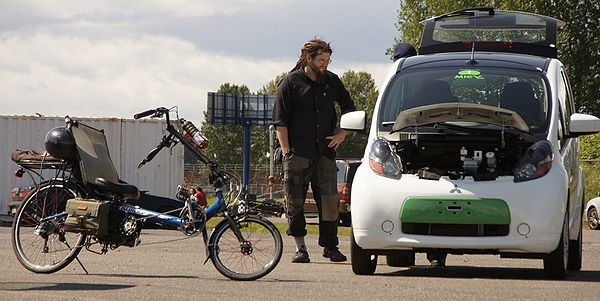
Here's the 2011 Electrathon at PIR where students compete with their school-built cars.
EV4Oregon.com[180] combines Solarworld panels, with Enphase microinverters, battery storage and 220 volt utility feeds to create Electric Vehicle carports that offers Level 1 (30 minute charging) without the expense of a 440 volt line drop[181]. The system claims a 20-minute electric vehicle charging capability by combining battery and 220 volt line power.
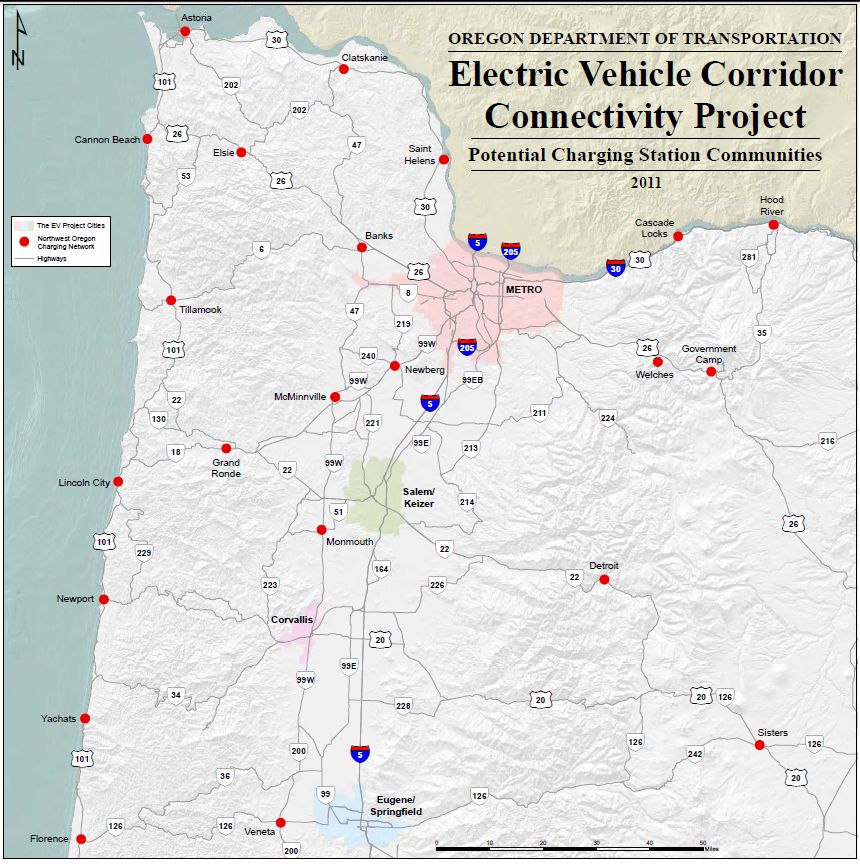
The City of Hillsboro is the first in the State of Oregon to install Coulomb Technologies[182] Level II ChargePoint Networked Charging Stations[183] for plug-in and electric vehicles. Thirteen Level II charging stations are now installed in downtown Hillsboro[184] at their new green intermodal transit facility. Portland-based Shorepower Technologies[185] is currently deploying Electrified Parking Spaces[186] (EPS) across North America. OpConnect, an Oregon company with offices in Beaverton, has developed a network of suppliers and partners for an Electric Vehicle Charging System.
The U.S. DOT awarded Oregon a $2 million TIGER II grant for a fast electric vehicle charging across the entire 1,350 miles of I-5, serving the 2 million electric vehicles anticipated on the west coast.
PGE installed the first publicly available fast charger in the United States in the summer of 2010 in its parking garage in downtown Portland. NEC's Takasago Rapid Charging Station[187] complies with the CHAdeMO[188] EV charging standard, and comes in 50kW and 20kW capacities[189] for 15-30 minute charging. A 20 minute quick charger[190] might utilize a 45-kilowatt photovoltaic carport[191].
Battery Innovation in Portland
ReVolt[192], with headquarters in Portland, is developing Zinc-Air batteries[193].

In a semi-solid flow cell battery, the cathodes and anodes are composed of particles suspended in a liquid electrolyte. These two different suspensions are pumped through systems separated by a filter, such as a thin porous membrane. The new design should make it possible to reduce the size and the cost of a complete battery system to about half the current levels. The MIT developed technology is being licensed to a company called 24M Technologies.
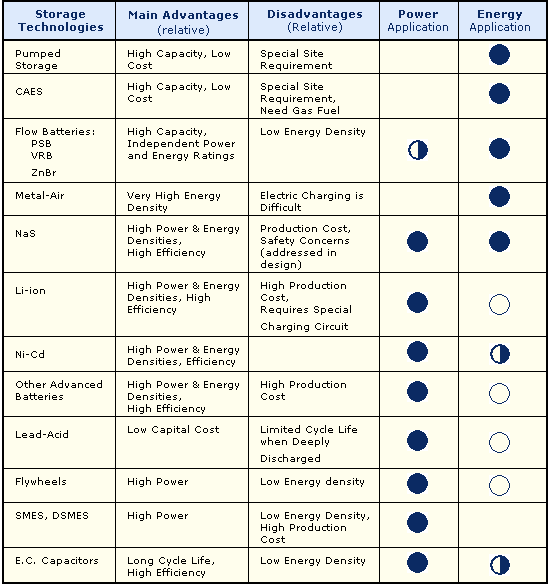
The Energy Storage Association says each technology has some inherent limitations.
A Portland-based battery developer, EnerSol Energy Systems, is putting lithium titanate batteries to the test, reports Sustainable Business Oregon, with a focus on grid storage and electric vehicles. The three-man company focuses on consulting and product development in batteries and energy systems for electric vehicles, grid storage, and portable devices.
Electric vehicles are anticipated to have a range of 200 to 400 miles in the foreseeable future. Lithium-air[194] is said to be the dream battery. Cost/effective batteries, with 2-3 times the present capacity, may largely resolve many range anxiety issues by allowing all day driving with overnight charging.
A Denmark battery company[195], Lithium Balance[196], has its eye on Portland as a potential U.S. headquarters. They build lithium batteries for industrial, military and consumer vehicles.

Lithium Balance hopes to make large Lithion Ion cells. Today, most battery packs are made from small cells, about the size of "D" batteries, in order to make them safer. The Prius Plug in and Hybrid uses NiMH batteries while the The Nissan Leaf uses a 24 kW/hr lithium-ion battery of their own design.
Lithium battery competition comes from A123 Systems, Ener1, Dow Kokam and LG Chem, which has set a goal of 25% global battery market share. The Volt's battery cells are produced by LG Chem in South Korea.
The overall market for energy storage technologies that power electric vehicles is set to grow from $13 billion in 2011 to $30 billion in 2016, a compound annual growth rate (CAGR) of 18%. But, while prominent plug-in passenger cars like the Chevy Volt and Nissan Leaf grab most of the headlines, the bulk of future growth will be driven by more humble vehicles, such as e-bikes and micro-hybrids, according to a new report from Lux Research.

Seattle's Sound Transit ordered 62 electric streetcars from Kinkisharyo. Their new LFX-300 ‘hybrid’ streetcar runs on batteries. It charges while running on overhead catenary power, but switches to internal 42K watt Lithium Ion batteries in feeder lines that eliminate expensive and ugly overhead power lines. Kinkisharyo's low-floor streetcar can be charged while running on catenary power and when braking. In battery mode it operate at full performance for up to five miles.
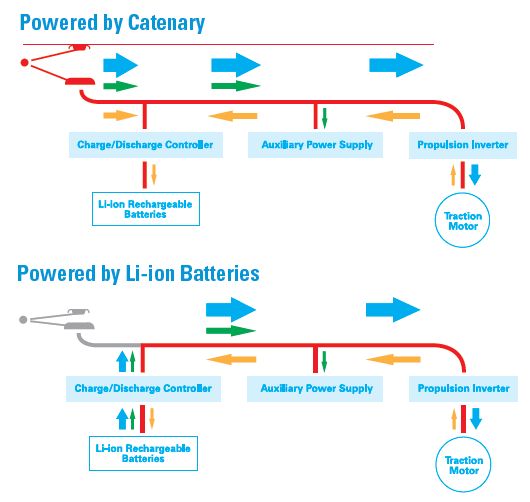
Ameritram says a 5 mile streetcar system, utilizing a fleet of 7 of their hybrid-powered streetcars, could save about $36 Million over the 30 year life of the system. Proterra manufactures battery powered transit buses, and raised $30 million from Kleiner Perkins Caufield & Byers and others. Their FastFill charging station charges a bus in 10 minutes.

Perhaps United Streetcar, a spin-off of Oregon Iron Works, might team with Revolt batteries for a cost/effective, made in USA solution. How long a route could you run on 100% batteries with no longer than a 15 minute charge? With Flow batteries that you can fill up like gas and other advances, some advocates expect a green transformation for mass transit - faster, quieter, cheaper and more attractive.

Excluding the $7,500 federal tax credit, the Volt and the Leaf, currently cost $41,000 and $32,780, respectively (both vehicles lease for $349 a month).
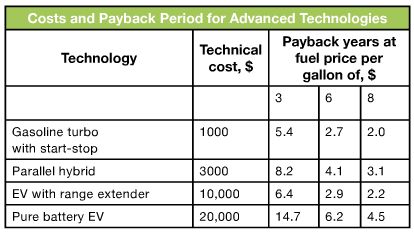
A 2010 Deloitte report, found that more than half of the US consumers would not be willing to pay more for an electric vehicle.
However, batteries are expected to get cheaper and longer range as gas gets more expensive. Energy Secretary Chu believes that before the end of the decade EVs will be “one-third the cost of today’s batteries with at least three times the range. Deloitte found that 70% of drivers surveyed wanted 300 mile range before purchasing one.
DriveOregon.org and the WestCoastGreenHighway[197] has the latest on charging stations. The Oregon Electric Vehicle Association has a Facebook page, Twitter Feed and Weekly Newspaper.
The mission of the U.S. Advanced Battery Consortium is to develop electrochemical energy storage technologies which support commercialization of fuel cell, hybrid, and electric vehicles. Here's everything you wanted to know about EV batteries.

A discovery of rare earths in international near Hawaii, reportedly contains 80 to 100 billion metric tons of rare earths, almost surpassing China’s 110 billion tons of proven reserves. For the electric vehicle industry, the consequences of this discovery are considerable. On average, each electric vehicle, be it plug-in or hybrid, contains 11 kg of rare earths, in particular neodymium, according to research by the New York Times. But developing the offshore bounty could take decades and cost billions, making it little more than a pipe dream, analysts say.
Questions Over Subsidies
The huge Shepherds Flat wind farm raises big questions about state, federal subsidies[198], reported the Oregonian in a three part investigative report, beginning on Mar 13, 2011.

According to The Oregonian[199], green energy subsidies has been treated like a state-sponsored ATM machine.

The Shepherds Flat wind farm[200] (BPA docs[201]), which may be the world's largest wind farm when it's completed in a couple of years, shows how Oregon provides millions of dollars to projects that would probably go forward without state subsidies, says the Oregonian.
The Department of Energy claims subsidies are essential to kick start home-grown sustainable power while the state of Oregon claims large subsidized projects can create a "hub", attracting many smaller supporting industries that will improve our economic outlook. The U.S. DOE announced a $1.3 billion loan guarantee[202], in Dec, 2010, to support Shepard's Flat.
It's a loan from the DOE, not a subsidy. That's an important difference, and never made clear in the Oregonian stories, advocates of wind power[203] say.
Similar kinds of incentives were made for SoloPower[204], a solar panel startup. That company was granted a $197 million loan guarantee by the DOE[205]. SoloPower will invest up to $340 million and bring as many as 500 jobs and received a $20 million loan from the State, while Solexant will build a $200 million solar module manufacturing plant in Gresham that could one day employ 1,000, and got a $25 million loan from the State.
Wilsonville would provide an estimated $11 million worth of redevelopment assistance to SoloPower, including a $4 million incentive package, of which 50 percent would be reimbursed to the city by Clackamas County, should anticipated tax revenue not exceed the advance. But former Wilsonville Mayor John Ludlow believed creating an urban renewal district for a single building, which is how the deal was structured, set a bad precedent. SoloPower didn't negotiate - they picked up their marbles. SoloPower will now build their plant in North Portland.
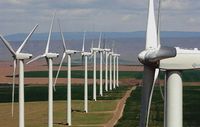
The controversial Business Energy Tax Credit system was overhauled by the Oregon Legislature after it came under fire for the size of the incentives and the management of the program. It lasts until June 2011.
There is no question that the State of Oregon IS helping to fund "green" industries with large tax credits. Opinions differ on the advisability of "green" investments.
It's a bet. Nobody in government, commerce or the news business knows if it will be a good bet.
Energy Financing
Iberdrola Renewables [206] is the world's largest renewable energy firm. The Spanish multinational is based in Valencia, Spain, with a headquarters office in Portland. It's the world's largest owner-operator of wind farms and operates solar, hydro, biomass and wave power businesses. Iberdrola Renovables[207] has 41 wind farms in the United States with an installed capacity of 3,877 megwatts[208], enough to power close to 1 million average U.S. households. ...MORE >>>
Coal Fired Power in Oregon
Coal. The United States is the Saudi Arabia of coal. We've got more coal than just about anybody. Half the electricity generated in the United States comes from coal. Today, more than 90 percent of the coal used in America goes to make electricity ...MORE >>>
Natural Gas in Oregon
Natural gas (in its gaseous state) may not be "renewable", but it is still relatively plentiful, cheap, clean and can be stored. Natural gas consists primarily of methane, and is used to generate about a quarter of all the electricity generated in the United States ...MORE >>>
Liquified Natural Gas in Oregon
Liquefied natural gas (LNG) is natural gas (predominantly methane) that has been converted temporarily to liquid form for ease of storage or transport. LNG takes up about 1/600th the volume of natural gas in the gaseous state. The Bradwood Landing LNG import terminal, near Astoria, was apparently stopped in March of 2011, when a 9th U.S. Circuit Court of Appeals decision threw out the license for the Bradwood Landing terminal ...MORE >>>
Bio Mass in Oregon
Oregon´s biomass resources include wood, agricultural crop residue and organic waste. Oregon DOE says biomass can be used to produce liquid fuels such as ethanol and biodiesel, generate electicity, or create bioproducts such as plastics or adhesives. Biomass uses plant or wood products like trees, wood chips, and yard clippings to generate electricity or produce heat. The Oregon Forest Resources Institute says about 15% of Oregon’s forestland have the potential to provide useful woody biomass through thinning. ...MORE >>>
Ethanol and Biodiesel in Oregon
Burning fossil fuel for transportation makes up about 33 percent of Oregon's greenhouse gas emissions, according to the NW Environmental Business Council. The United States is the world's largest producer of ethanol fuel since 2005 Wikipedia. The U.S. produced 10.6 billion U.S. liquid gallons of ethanol fuel in 2009, and together with Brazil, both countries accounted for 89% of the world's production in that year. Ethanol fuel is mainly used in the U.S. as an oxygenate to gasoline in the form of low-level blends, and to a lesser extent, as fuel for E85 flex-fuel vehicles. Most ethanol fuel in the U.S. is produced using corn. Brazil uses sugar cane. ...MORE >>>
Fuel Cells in Oregon
Fuel cells convert energy from a fuel into electrical energy. Hydrogen fuel cells generate electricity through an electrochemical reaction using hydrogen and oxygen. Fuel cells are different from conventional batteries in that they can be "recharged" by simply filling them up with more fuel, typically hydrogen. Fuel cells are clean in that their "waste" output is plain water. Hillsboro-based ClearEdge Power makes fuel cells, which use natural gas to generate electricity. Southern California Gas invested $1 million in ClearEdge. ...MORE >>>
Nuclear Power
There are 104 nuclear reactors in the United States that provide 20 percent of America's electric power, according The Hanford News. They were designed and built in the 1960s and '70s, an era when seismologists knew much less about earthquakes than they do today. ...MORE >>>
Co-generation in Oregon
Cogeneration power stations can simultaneously generate both electricity and useful heat (through steam). Cogeneration plants produce both electricity and steam from one fuel source, which may be natural gas, wood or coal. Excess process steam from a cogeneration plant can go to lumber mills, for example. Oregon is a hotbed for development of cogeneration and other biomass technologies that involve turning trees, brush, straw and other organic materials into electricity. ...MORE >>>
Geothermal Power in Oregon
Geothermal comes from the Greek words meaning earth heat, explains the Oregon Department of Energy. Oregon ranks 5th among states in the number of geothermal projects being developed, and has 9 geothermal projects in production. ...MORE >>>
Green Buildings
The City of Portland adopted a green building policy and funded a Green Building Initiative, which is designed to expand market demand and provide technical services and resources for the building industry. The Portland-based International Living Building Institute administers Living Building Challenge, a performance standard more ecologically rigorous than the U.S. Green Building Council's Leadership in Energy and Environmental Design (LEED) Platinum rating. ...MORE >>>
Energy Storage in Oregon
Energy storage is often a problem with renewables. Utility power is designed to meet peak demand. Dams can store water and run 24/7, while coal and gas fired power plants can kick on to meet peak demand - but the sun and wind are not predictable. Energy can be stored locally (using batteries), but utility companies are looking into large scale storage alternatives such as underground storage of pressurized air, flywheels, or other techniques. ...MORE >>>
Inverters and Electronics in Oregon
PV Powered, based in Bend, designs and manufactures inverters, devices which convert the direct current produced by solar panels into the alternating current supplied by electric utilities. Proponents of micro-inverters believe the technology makes the system more reliable, smarter, and efficient by increasing energy harvesting through optimal MPPT at the module level. ...MORE >>>
The Smart Grid in Oregon
The Smart Grid is an enhancement to the power grid that delivers electricity from suppliers to consumers using two-way communications to control appliances. When power is least expensive the user can allow the smart grid to turn on selected appliances. A Home Area Network ties into the "smart meter", using powerline or RF standards such as ZigBee, INSTEON, Zwave, WiFi and others. The $178 million Pacific Northwest Smart Grid Demonstration Project is one of 16 regional smart grid demonstration awards announced by DOE in the fall of 2010. It contains key functions of the future smart grid. The project team will install equipment and technology now through mid-2012. Then, for about the next two years, project leaders will gather data on smart grid performance. ...MORE >>>
Solar Projects in Portland
The Oregon Public Utility Commission has a Solar Pilot Program. The PUC approves solar incentive rates.
The PUC's Solar Pilot Program enables customers who install photovoltaic systems to receive a monthly check from their utility for the energy generated by the solar system based on the incentive rate minus the rate they currently pay. Plus, their overall electric bill is reduced. The size of the solar system cannot be greater than 90 percent of historical energy usage for a home or business. Total program capacity for the four-year Pilot Project is 25 megawatts (MW). Portland General Electric has been allocated 14.9 MW, Pacific Power & Light 9.8 MW.
Portland has partnered with Solar America Communities and started their own, “Solar Now!” organization. People in the community are volunteering their time to help bring solar into as many homes as possible. ...MORE
What Can I Do to support sustainability?
We can simply waste less. Poor insulation, inefficient appliances and wasteful habits send lots of energy up the chimney. The desire to buy stuff that doesn't really make us happy, doesn't help. Common sense and passion can go a long way.
There are many positive trends. Solar power is becoming more efficient and localized, buildings are getting greener and more self-sufficient, vehicles are getting electrified and using less fossil fuel, and people are more aware of their impact.
There are as many ways to become engaged as there are people.
More Information
Energy Trust of Oregon provides cash incentives for customers of PGE, Pacific Power, NW Natural and Cascade Natural Gas. The Oregon Department of Energy has more information on sustainable energy programs.
External Links
- 85+ Wind and Solar Energy Companies now in Greater Portland, Ore.
- Portland Tribune: Sustainable Life
- SustainableBusinessOregon.com
- Oregon Energy Links
- Sustainable Business Network of Portland
- TheGreenEconomy.tv
- OBP: Ecotrope
- Portland Tribune: China Connection
- City of Portland Energy Policy
- Solarize Portland
- Portland's Ecoroof Program
- Portland's Solar Energy Program
- Oregon Resources: Green Building
- Green Building Council
- Oregon Geothermal
- Oregon Dept of Energy
- Sustainable Oregon Business
- Energy Trust of Oregon
- PGE's GreenPowerOregon.com
- State Incentives for Alternative Energy
- American Wind Energy Association
- National Renewable Energy Laboratory
- PV Magazine
- PV-Tech News
- DriveOregon.org
- AutoBlog Green
- Oregon's Electric Vehicle Charging Network
- Columbia Gorge Energy Tour (Flickr)
References
- ↑ Portland City Council Supports Oregon Sustainability Center
- ↑ Oregon Sustainability Center
- ↑ ODOE: Renewable Energy.
- ↑ Oregon's Renewable Resource Programs
- ↑ Energy Trust of Oregon
- ↑ Wind power in the United States
- ↑ Solar Power Is Cheaper Than Nuclear for the First Time
- ↑ The U.S. spends about $1 billion a day importing oil, which is now over $100 a barrel
- ↑ according to Energy Secretary Steven Chu
- ↑ The Dalles Dam
- ↑ The Grand Coulee Dam
- ↑ The Pacific DC Intertie
- ↑ Bonneville's grid
- ↑ The main renewable energy industries grew 35% last year
- ↑ Clean Energy Trends
- ↑ Grid parity
- ↑ low-carbon economy
- ↑ Zero carbon emissions globally by 2050
- ↑ Vestas
- ↑ About 4 percent of PGE's energy comes from wind farms
- ↑ Biglow Canyon Wind Farm
- ↑ Klondike II
- ↑ Vansycle Ridge
- ↑ Stateline Wind Farm
- ↑ along the Columbia River
- ↑ Biglow Canyon Wind Farm
- ↑ Vestas wind turbines
- ↑ The wind farm is located in Wasco County
- ↑ [http://djcoregon.com/news/2010/09/08/pge-completes-bigelow-wind-farm/ The $1 billion project was completed in September, 2010
- ↑ Vestas
- ↑ Here's a video tour
- ↑ at Biglow
- ↑ Sam Churchill's Flickr photo collection
- ↑ Shepherds Flat Wind Farm
- ↑ Caithness Energy
- ↑ Southern California Edison
- ↑ Eastern Oregon wind farms, especially the Summit Ridge wind farm in Wasco County, have now been thrown into doubt
- ↑ Iberdrola Renewables
- ↑ the second largest provider
- ↑ an installed capacity of 3,877 megwatts
- ↑ Klondike Wind Power
- ↑ Bonneville Power Administration
- ↑ Sales of small wind turbines
- ↑ American Wind Energy Association
- ↑ Xzeres
- ↑ Oregon Wind's small vertical Helyx
- ↑ As of November 2010
- ↑ Roscoe Wind Farm
- ↑ Horse Hollow Wind Energy Center
- ↑ Alta Wind Energy Center
- ↑ Gansu Wind Farm
- ↑ PGE
- ↑ hopes to shut down the state's only coal-fired power plant 20 years earlier
- ↑ carbon taxes
- ↑ The 585-megawatt coal fired plant
- ↑ grew 67 percent to $6 billion in 2010
- ↑ Solar Energy Industries Association
- ↑ Crystalline silicon panels
- ↑ SolarWorld in Hillsboro, Oregon
- ↑ 90% of the industry today
- ↑ Monocrystalline silicon
- ↑ Crystalline silicon
- ↑ Cadmium Telluride
- ↑ Copper Indium Gallium Selenide
- ↑ Thin-film technology has proved challenging to commercialize
- ↑ Cadmium telluride
- ↑ CIGS
- ↑ Cadmium telluride panel
- ↑ Solexant
- ↑ SoloPower
- ↑ represent a huge shift in energy economics
- ↑ SolarWorld
- ↑ its 210,000-square-foot addition
- ↑ SolarWorld will collaborate develop a 11.6-megawatt solar system
- ↑ SANYO Solar
- ↑ opened a monocrystalline growing facility in Salem, Ore
- ↑ Cadmium Telluride developer Solexant
- ↑ plans to build a $200 million solar manufacturing plant in Gresham
- ↑ Solexant's facility in Oregon
- ↑ CdTe
- ↑ the largest nanotechnology manufacturing facility in the world
- ↑ reports Oregon Live
- ↑ CIGs developer SoloPower
- ↑ to build a manufacturing plant in Wilsonville
- ↑ could employ 500 people within five years
- ↑ tough but flexible solar panels
- ↑ expansion plans call for three more manufacturing lines
- ↑ Grape Solar
- ↑ it just imports low-cost solar panels from China and re-sells them here
- ↑ Advanced Energy Systems
- ↑ The nation’s first Solar Highway project
- ↑ PGE’s “Oregon Solar Highway”
- ↑ Solar Energy Grid Integration Systems
- ↑ Teanaway Solar Reserve
- ↑ a 75-megawatt plant made up of 400,000 photovoltaic panels
- ↑ 4 miles North of Cle Elum, Washington
- ↑ The SuNRISE lab
- ↑ Microinverters
- ↑ Enphase
- ↑ online monitoring of your installation
- ↑ a 4.81 kW solar array in Portland
- ↑ PV Powered
- ↑ 260kW, 97% efficient
- ↑ National Renewable Energy Laboratory
- ↑ In Germany, the industry boomed after the Renewable Energy Act in 2000
- ↑ According to three industry experts
- ↑ Solar is cheaper than nuclear energy
- ↑ Duke University
- ↑ around 13.6 GW of PV will be installed this year
- ↑ will get to $2 per watt within the next five years
- ↑ But Oregon didn’t make the list
- ↑ The largest solar power installation in the world
- ↑ 48-MW Copper Mountain Solar Facility in Nevada
- ↑ Copper Mountain Solar Facility
- ↑ NRG Energy
- ↑ Agua Caliente solar project
- ↑ approved a thousand-megawatt, $6 billion solar project in California
- ↑ will have to cost $1 per watt says the DOE
- ↑ Wave Power
- ↑ Wave energy
- ↑ committed $200 million in federal funds toward wave energy technology
- ↑ The nation's first commercial wave-energy farm
- ↑ Ocean Power Technologies
- ↑ to have a capacity of 1.5 megawatts
- ↑ Surfpower
- ↑ an interest in exploring their options in Oregon
- ↑ Oregon Wave Energy Trust
- ↑ Ocean Power Technologies
- ↑ close to getting a license to build a wave energy plant off the coast of Oregon
- ↑ a 150 kW wave energy station
- ↑ A 10-Megawatt OPT power station
- ↑ Ocean Power Technologies has contracted with Oregon Iron Works
- ↑ Columbia Power Technologies
- ↑ the first ocean energy device to produce kilowatt scale electrical energy
- ↑ between one and three miles offshore
- ↑ Grays Harbor Ocean Energy
- ↑ is currently a hotly debated topic
- ↑ The trick is to tap the benefits of a new industry without spoiling ocean habitats, economic livelihoods and recreational playgrounds
- ↑ Off shore energy policy
- ↑ No state agency in the U.S has ever permitted a wave energy project
- ↑ Finavera
- ↑ Aquamarine
- ↑ Wave Energy A/S
- ↑ a possible Texas-based
- ↑ Neptune Wave Power
- ↑ Northwest National Marine Renewable Energy Center
- ↑ tidal energy
- ↑ National Renewable Energy Laboratory
- ↑ Pacific Energy Ventures
- ↑ Oregon Wave Trust
- ↑ Oregon Wave Energy Trust
- ↑ The U.S. has lurched from different transportation energy policies
- ↑ Oregon is coordinating many activities to facilitate successful, widespread deployment of plug-in vehicles
- ↑ Oregon's strategy for greenhouse gas reduction report
- ↑ There are 40 companies building either electric vehicles or component parts
- ↑ Drive Oregon
- ↑ Oregon-made electric vehicles
- ↑ Arcimoto
- ↑ Brammo
- ↑ Ryno Motors
- ↑ Green Lite Motors
- ↑ MotoCzysz
- ↑ Shorepower
- ↑ http://www.opconnect.com/welcome.aspx Optimization Technologies]
- ↑ grid energy storage
- ↑ Nissan Leaf
- ↑ all electric car
- ↑ Chevrolet Volt
- ↑ Ford's Focus Electric
- ↑ Plug-in hybrids
- ↑ Chevrolet's Volt
- ↑ Toyota Prius
- ↑ The plug-in hybrid Prius
- ↑ Nissan Leaf
- ↑ Lithium Ion batteries
- ↑ The Navistar eStar
- ↑ [http://www.oregon.gov/ODOT/HWY/OIPP/inn_ev-charging.shtml/ Oregon's Electric Vehicle Charging Network
- ↑ ECOtality's Fast chargers
- ↑ Washington State's Electric Highway project
- ↑ EV4Oregon.com
- ↑ offers Level 1 (30 minute charging) without the expense of a 440 volt line drop
- ↑ Coulomb Technologies
- ↑ ChargePoint Networked Charging Stations
- ↑ Thirteen Level II charging stations are now installed in downtown Hillsboro
- ↑ Shorepower Technologies
- ↑ Electrified Parking Spaces
- ↑ NEC's Takasago Rapid Charging Station
- ↑ CHAdeMO
- ↑ 50kW and 20kW capacities
- ↑ A 20 minute quick charger
- ↑ a 45-kilowatt photovoltaic carport
- ↑ ReVolt
- ↑ developing Zinc-Air batteries
- ↑ Lithium-air
- ↑ A Denmark battery company
- ↑ Lithium Balance
- ↑ WestCoastGreenHighway
- ↑ the huge Shepherds Flat wind farm raises big questions about state, federal subsidies
- ↑ The Oregonian on Wind Subsidies
- ↑ Shepherds Flat wind farm
- ↑ BPA docs
- ↑ The U.S. DOE announced a $1.3 billion loan guarantee
- ↑ advocates of wind power
- ↑ SoloPower
- ↑ a $197 million loan guarantee by the DOE
- ↑ Iberdrola Renewables
- ↑ Iberdrola Renovables (Wikipedia)
- ↑ an installed capacity of 3,877 megwatts
Big text